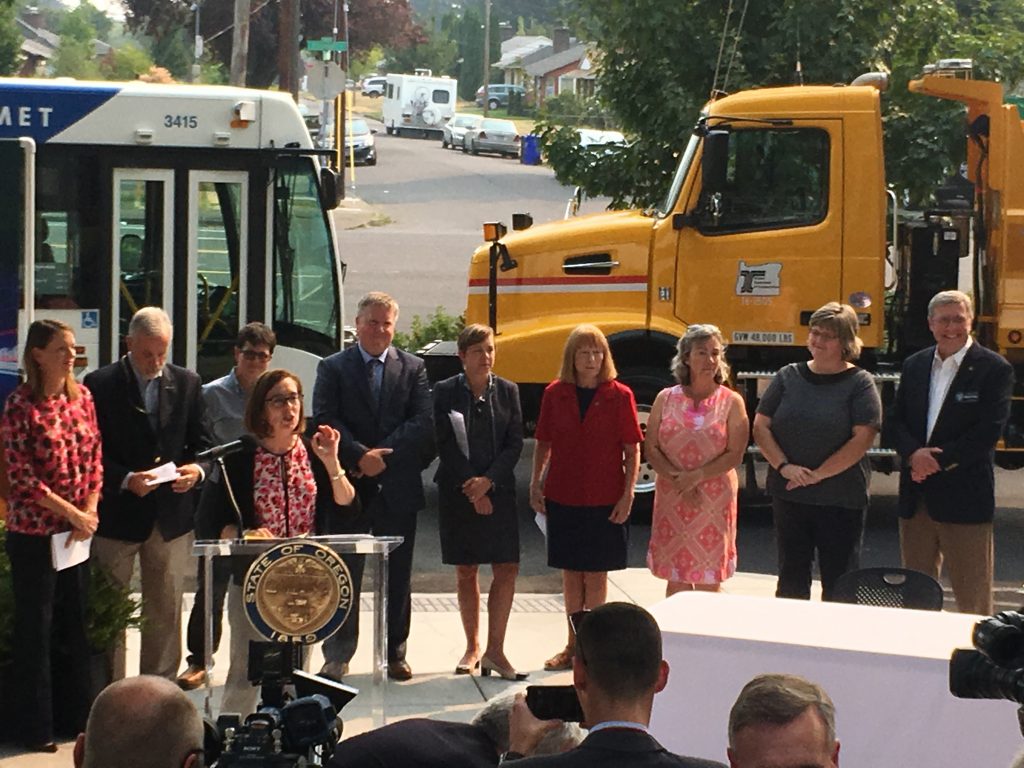Passing Oregon’s transportation package was just the beginning of the hard work
Governor Kate Brown is conducting signing ceremonies in communities throughout Oregon this week to celebrate the passage of Oregon’s transportation package. While the governor, legislature, and stakeholders are enjoying this victory lap on a big legislative effort, the hard work of implementing the bill is yet to come.

“The transportation package is truly a roadmap to Oregon’s future. Let’s keep Oregon moving forward.” Gov. Kate Brown speaking at a signing ceremony earlier this week.
HB 2017 represents a big investment in transportation for Oregon – $5.3 billion over 10 years, with over $1 billion in state dollars dedicated to transit. But there are many questions remaining about how that funding will be spent.
Over the 10-year timeframe the package dedicates almost $800 million for a variety of earmarks; however, most earmarks are not cost-specific, shifting numerous critical decisions to later dates. Instead, each region receives a determined amount of funding for multiple projects.
This lack of specificity could be a curse or a blessing. Oregon’s DOT and the Oregon Transportation Commission (OTC) could interpret the lack of specificity as flexibility to spend designated dollars more effectively, like scoping projects to maximize return on investment. But to do so, they’ll need to apply “practical solutions” effectively.
The bill more than triples state funding for public transit. This will require the OTC to develop and finalize rules in less than a year for rationally distributing over $100 million each year in new funding to a wide variety of transit agencies — urban and rural, large and small. How will the OTC and local transit agencies quickly develop a process to demonstrate accountability and transparency in distributing and using that funding effectively?
A big challenge for implementers of this bill is that it’s not big enough to address everything. While the bill includes substantial new funding for repair, many roads and bridges in the state will continue to deteriorate. The freeway bottlenecks addressed in the bill are only a small subset of those in the Portland region, and may become clogged again due to induced demand in a few years. Will the public understand the limits of the package the legislature passed, even as they see their taxes increase?
The bill requires study and possible implementation of congestion pricing on major freeways in Portland. ODOT is already hiring for new positions to tackle this challenge. Congestion pricing (also called value pricing) has the potential to address many of Oregon’s congestion challenges in a fundamental way, but that doesn’t necessarily make it any easier. While shown to be highly effective in several cases, value pricing is politically difficult and a new technical challenge for Oregon.
Passing the bill was a huge success, but that was just part of what’s needed.
If Oregon’s leaders don’t construct a strong framework for accountability and measuring performance, it’ll be like making a great pass but then kicking the ball back into their own goal. Oregon’s work on this transportation bill is far from done, and those involved in passing the bill have much work to do to deliver on its promise to Oregonians.




















1 Comment